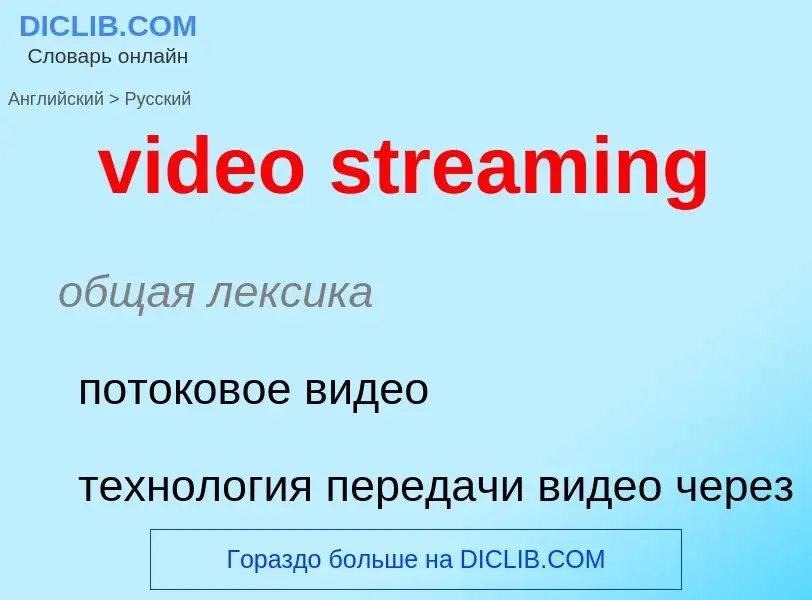Перевод и анализ слов искусственным интеллектом ChatGPT
На этой странице Вы можете получить подробный анализ слова или словосочетания, произведенный с помощью лучшей на сегодняшний день технологии искусственного интеллекта:
- как употребляется слово
- частота употребления
- используется оно чаще в устной или письменной речи
- варианты перевода слова
- примеры употребления (несколько фраз с переводом)
- этимология
video streaming - перевод на Английский
общая лексика
потоковое видео
технология передачи видео через Интернет
синоним
общая лексика
потоковое видео
технология передачи видеоизображения, позволяющая просматривать его по мере поступления данных непосредственно из Сети, без предварительной загрузки всего видеофайла на локальный компьютер
Смотрите также
общая лексика
(Voice Over Data) передача голоса поверх данных
синоним
Смотрите также
общая лексика
VOD, VoD
видео по запросу
система индивидуальной доставки абоненту телевизионных программ или видеофильмов по кабельной сети (или ISDN) с мультимедиа- или видеосервера, где они хранятся в сжатом (обычно в формате MPEG) виде
Смотрите также
Смотрите также
математика
момент распределения
['stri:miŋ]
общая лексика
потоковый
истечение
поток
протекание
течение
прилагательное
общая лексика
текучий и пр.
существительное
['stri:miŋ]
общая лексика
течение
вытекание и пр.
система потоков (в школах)
распределение школьников по классам в зависимости от их способностей
склонностей и т. п.
распределение учащихся по параллельным классам с учетом их способностей (в англ. школах)
добыча полезных ископаемых
промывка руды (в текучей воде)
общая лексика
потоковое аудио
технологии программного воспроизведения в реальном времени получаемых через Интернет звуковых файлов без их предварительного скачивания в компьютер
Смотрите также
Определение
Устройство для дистанционного ввода или вывода информации в вычислительных системах, оснащенное экраном визуального контроля.
Википедия
Video on demand (VOD) is a media distribution system that allows users to access videos without a traditional video playback device and the constraints of a typical static broadcasting schedule. In the 20th century, broadcasting in the form of over-the-air programming was the most common form of media distribution. As Internet and IPTV technologies continued to develop in the 1990s, consumers began to gravitate towards non-traditional modes of content consumption, which culminated in the arrival of VOD on televisions and personal computers.
Unlike broadcast television, VOD systems initially required each user to have an Internet connection with considerable bandwidth to access each system's content. In 2000, the Fraunhofer Institute IIS developed the JPEG2000 codec, which enabled the distribution of movies via Digital Cinema Packages. This technology has since expanded its services from feature-film productions to include broadcast television programmes and has led to lower bandwidth requirements for VOD applications. Disney, Paramount, Sony, Universal and Warner Bros. subsequently launched the Digital Cinema Initiative, in 2002.
Television VOD systems can stream content, either through a traditional set-top box or through remote devices such as computers, tablets, and smartphones. VOD users can permanently download content to a device such as a computer, digital video recorder (DVR) or a portable media player for continued viewing. The majority of cable and telephone company–based television providers offer VOD streaming, whereby a user selects a video programme that begins to play immediately, or downloading to a DVR rented or purchased from the provider, or to a PC or to a portable device for deferred viewing.
Streaming media has emerged as an increasingly popular medium of VOD provision. Desktop client applications such as the Apple iTunes online content store and Smart TV apps such as Amazon Prime Video allow temporary rentals and purchases of video entertainment content. Other Internet-based VOD systems provide users with access to bundles of video entertainment content rather than individual movies and shows. The most common of these systems, Netflix, Hulu, Disney+, Peacock, HBO Max and Paramount+, use a subscription model that requires users to pay a monthly fee for access to a selection of movies, television shows, and original series. In contrast, YouTube, another Internet-based VOD system, uses an advertising-funded model in which users can access most of its video content free of cost but must pay a subscription fee for premium content. Some airlines offer VOD services as in-flight entertainment to passengers through video screens embedded in seats or externally provided portable media players.

![Some VOD services require the viewer to have a TV set-top box. This photo shows the set-top box for the Jazzbox VOD service and its accompanying [[remote control]]. Some VOD services require the viewer to have a TV set-top box. This photo shows the set-top box for the Jazzbox VOD service and its accompanying [[remote control]].](https://commons.wikimedia.org/wiki/Special:FilePath/Jazzbox.jpg?width=200)


![Live streaming service at zoo by [[Niconico]] Live streaming service at zoo by [[Niconico]]](https://commons.wikimedia.org/wiki/Special:FilePath/羽村市動物公園 ニコ生 2017 (32782507624).jpg?width=200)
